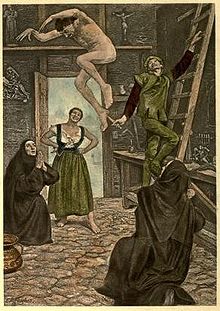The Facetious Nights of Straparola

Night the Ninth, Sixth Fable
Watercolor by E. R. Hughes
The Italian Novelists, Volume 3
The Facetious Nights of Straparola (1550–1555; Italian: Le piacevoli notti), also known as The Nights of Straparola, is a two-volume collection of 75[1] stories by Italian author and fairy-tale collector Giovanni Francesco Straparola. Modeled after Boccaccio's Decameron, it is significant as often being called the first European storybook to contain fairy-tales;[2] it would influence later fairy-tale authors like Charles Perrault and Jacob and Wilhelm Grimm.
History[]
The Facetious Nights of Straparola was first published in Italy between 1550–53[1] under the title Le piacevoli notti ("The Pleasant Nights") containing 74 stories. In 1555 the stories were published in a single volume in which one of the tales was replaced with two new tales, bringing the total to 75.[1] Straparola was translated into Spanish in 1583. In 1624 it was placed on the Index of Prohibited Books.[1]
The work was modeled on Boccaccio's Decameron with a frame narrative and novellas, but it took an innovative approach by also including folk and fairy tales.[1] In the frame narrative, participants of a party on the island of Murano, near Venice, tell each other stories that vary from bawdy to fantastic.[3] The narrators are mostly women, while the men, among whose ranks are included historical men of letters such as Pietro Bembo and Bernardo Cappello, listen.[1] The 74 original tales are told over 13 nights, five tales are told each night except the eighth (six tales) and the thirteenth (thirteen tales).[1] Songs and dances begin each night, and the nights end with a riddle or enigma.[1] The tales include folk and fairy-tales (about 15); Boccaccio-like novellas with themes of trickery and intrigue; and tragic and heroic stories.[1]
The 15 fairy tales were influential with later authors, some were the first recorded instances of now-famous stories, like "Puss in Boots".[1] Many of the tales were later collected or retold in Giambattista Basile’s The Tale of Tales (1634–36) and Jacob and Wilhelm Grimm's Grimm's Fairy Tales (1812–15).[1]
Fairy tales[]
Fairy tales that originally appeared in Nights of Straparola, with later adaptations by Giambattista Basile, Madame d'Aulnoy, Charles Perrault, Carlo Gozzi, Jacob and Wilhelm Grimm.[4]
- 1.2, “Cassandrino” (Grimms’ "The Master Thief")[1]
- 1.3, “Pre Scarpacifico” (Grimms’ "Little Farmer")[1]
- 1.4, “Tebaldo and Doralice[5]” (Basile's "The Bear"; Charles Perrault's "Donkeyskin"; the Grimms’ "All-Fur" or All-Kinds-of-Fur)[1]
- 2.1, “The Pig King” (d'Aulnoy's "Prince Marcassin", Grimms’ "Hans My Hedgehog")[1]
- 3.1, “Crazy Peter” (Basile's "Peruonto"; d'Aulnoy's "The Dolphin"; Grimms’ "")[1]
- 3.2, “Livoretto” (Aulnoy's "The Story of Pretty Goldilocks")
- 3.3, “Biancabella and the Snake” (elements of Basile's "Penta With the Chopped-Off Hands" and "The Two Little Pizzas")[1]
- 3.4, “” (elements of the Grimms’ "The Nixie in the Pond")[1]
- 4.1, “Costanza / Costanzo” (d'Aulnoy's "Belle-Belle ou Le Chevalier Fortuné", Grimms’ "How Six Made Their Way in the World")[1]
- 4.3, “Ancilotto, King of Provino” (Grimms’ "The Three Little Birds"; d'Aulnoy's "Princess Belle-Etoile"; Carlo Gozzi's "The Green Bird"; Crane's "The Dancing Water, the Singing Apple, and the Speaking Bird")[1]
- 5.1, “Guerrino and the Savage Man” (Grimms’ "Iron Hans")[1]
- 5.2, “Adamantina” (Basile's "The Goose"; Grimms’ "The Golden Goose")[1]
- 7.5, “The Three Brothers” (Basile's "The Five Sons"; Grimms’ "The Four Skillful Brothers")[1]
- 8.4, “Maestro Lattantio and His Apprentice Dionigi” (Grimms’ "The Thief and His Master")[1]
- 10.3, “Cesarino di Berni” (Basile's "The Merchant"; Grimms’ "The Two Brothers")[1][6]
- 11.1, “Costantino Fortunato” (Basile's "Cagliuso"; Perrault's "Puss in Boots")[1]
References[]
- ^ a b c d e f g h i j k l m n o p q r s t u v w x y z Nancy Canepa. "Straparola, Giovan Francesco (c. 1480–1558)" in The Greenwood Encyclopedia of Folktales and Fairy Tales, 3-volumes, edited by , Greenwood Press, 2008, pages 926–27.
- ^ Opie, Iona; Opie, Peter (1974), The Classic Fairy Tales, Oxford and New York: Oxford University Press, ISBN 0-19-211559-6 See page 20. The claim for earliest fairy-tale is still debated, see for example Jan M. Ziolkowski, Fairy tales from before fairy tales: the medieval Latin past of wonderful lies, University of Michigan Press, 2007. Ziolkowski examines Egbert of Liège's Latin beast poem Fecunda Ratis (The Richly Laden Ship, c. 1022/24), the earliest known version of "Little Red Riding Hood". Further info: Little Red Pentecostal Archived 2007-10-23 at the Wayback Machine, Peter J. Leithart, July 9, 2007.
- ^ Jack Zipes, The Great Fairy Tale Tradition: From Straparola and Basile to the Brothers Grimm, p 841, ISBN 0-393-97636-X
- ^ Giovanni Francesco Straparola (2012). "Introduction". In Beecher, Donald (ed.). The Pleasant Nights. 1. Translated by Waters, W. G. Toronto, Canada: University of Toronto Press. pp. 90–92. ISBN 9781442699519.
- ^ "Donkeyskin Annotated Tale". Retrieved 19 August 2021.
- ^ Giovanni Francesco Straparola (2012). "Cesarino the Dragon Slayer". In Beecher, Donald (ed.). The Pleasant Nights. 2. Translated by Waters, W. G. Toronto, Canada: University of Toronto Press. pp. 361–393. ISBN 9781442699533.
Further reading[]
- Ruth B. Bottigheimer, Fairy Godfather: Straparola, Venice, and the Fairy Tale Tradition (University of Pennsylvania Press, 2002).
External links[]
| Italian Wikisource has original text related to this article: |
- The Nights of Straparola, trans. W.G.Waters 1894. Scanned original color illustrated editions.
- The Italian Novelists (vol. 1–4), trans. W.G.Waters 1901–04. Scanned original color illustrated editions. Note: this edition differs slightly in content from the 1894 edition.
- SurLaLune Fairy Tale Pages: The Facetious Nights of Straparola
- Collections of fairy tales